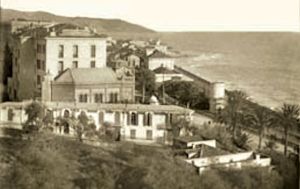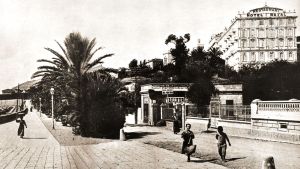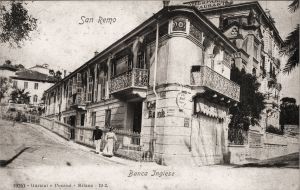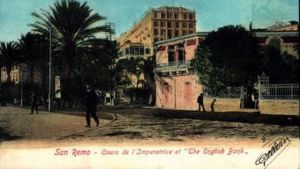Buildings that marked a historical era but no longer exist
The Alexandra Tea Room
 The building in the photo was at the beginning of Corso Regina Margherita, which after the war was named after Luigi Nuvoloni, a hero of the Resistance. It existed before the Hotel Riviera Palace (1903).
The building in the photo was at the beginning of Corso Regina Margherita, which after the war was named after Luigi Nuvoloni, a hero of the Resistance. It existed before the Hotel Riviera Palace (1903).

 At the beginning it was a tailor's shop and over the years it was raised by one floor, lengthened at the back and housed in order: the Pensione Azzurra, the English Bank (owned by the Asquasciati family) and finally the Alexandra Café and Tea Room.
At the beginning it was a tailor's shop and over the years it was raised by one floor, lengthened at the back and housed in order: the Pensione Azzurra, the English Bank (owned by the Asquasciati family) and finally the Alexandra Café and Tea Room.

For a time, the latter also had a bridge room run by Princess Melikoff of Krusenijerna.
The building, which had taken on a pleasant Art Nouveau style after being transformed, was demolished in 1936 as part of the road widening work carried out by the Guidi administration to make way for the Rivera Square.
In the course of the works, which completely altered and transformed the physiognomy of the area, only one Ficus Macrofila plant was spared, which grew in a small garden between the Scottish church and the Alexandra and which still today, having become gigantic, towers over the road.
Further information:
Around the time the building was used by the Asquasciati brothers as the English Bank during the crisis, this article appeared in a local newspaper, in 1915 at the start of the Great War dated 9 February:
"Banca Asquasciati has closed its doors. Demand for arrears. La situazione dell'Istituto - Giacomo Gandolfi, telephoned us at 19.00 hours:
 For several days there had been whispers that a credit institution in our town was in difficulty because of the economic crisis which had been going on since last August. Having obtained reliable information, I learned that the bank in question is the ancient and well-known Asquasciati Brothers Bank.
For several days there had been whispers that a credit institution in our town was in difficulty because of the economic crisis which had been going on since last August. Having obtained reliable information, I learned that the bank in question is the ancient and well-known Asquasciati Brothers Bank.
I can assure you, however, that it is not a matter of disaster, but of an embarrassment that has grown over the last few days due to the excessive influx of depositors withdrawing their deposits, so that the Bank, unable to liquidate its considerable securities and assets, has decided to ask creditors for a delay in order to reach a calm and well-considered liquidation.
I did not think it opportune to inform you immediately because negotiations were underway with a national institution to save the situation. This morning, however, the Bank was not opening its doors and a sign warned customers to contact the notary Roverio for clarification. Naturally, this caused the most distressing impression on the entire townspeople and neighbouring municipalities, where there are many depositors. On the other hand, it is claimed that the assets are greater than the liabilities, and this circumstance will serve to advise a confident calm in our populations.
Even as early as this morning, the public in the vicinity of the Bank had the impression that depositors will undoubtedly agree to devise means to avoid harmful complications. For the record, the sums deposited amounted to some ten million and the securities and property of the Asquasciati brothers to over 12 million. The financial distress is essentially due to the seriousness of the international situation, which has caused a very sharp fall in all securities'.
(sources: elaboration from texts by various authors including Roberto Colombo; images from Private Archive)
The Little House of Roses This was a tiny building located at the end of Via Roccasterone in an elevated position more or less where the staircase leading to the street level now stands.
This was a tiny building located at the end of Via Roccasterone in an elevated position more or less where the staircase leading to the street level now stands. The beautiful location, private and comfortable at the same time, made it an ideal meeting place for classy couples, turning it into the VIP Tea Room for a while.
The beautiful location, private and comfortable at the same time, made it an ideal meeting place for classy couples, turning it into the VIP Tea Room for a while.
The Casinetta was destroyed in 1936 as part of the work to widen Corso Imperatrice.
These works required the sacrifice of many properties but gave a wider scope to the west entrance of Sanremo as it had happened to the east at the beginning of the century with the enlargement and the arrangement of Corso Cavallotti.
(sources: text by Roberto Colombo; private images)
The House of the Birds
 Along the Corso dell'Imperatrice, just in front of the Hotel Royal, there was a building that was called the House of the Birds, because it seems, but has not been documented, that there were stuffed birds inside.
Along the Corso dell'Imperatrice, just in front of the Hotel Royal, there was a building that was called the House of the Birds, because it seems, but has not been documented, that there were stuffed birds inside.
 Its existence, however, was not due to this, but rather to the fact that it served as a forepart of the Hotel itself. In fact, in its various changes of name, one can read on the wall: "Route du G.Hotel Royal", "Hotel Restaurant" as can be seen in the various pictures below.
Its existence, however, was not due to this, but rather to the fact that it served as a forepart of the Hotel itself. In fact, in its various changes of name, one can read on the wall: "Route du G.Hotel Royal", "Hotel Restaurant" as can be seen in the various pictures below.
 It was demolished, like other neighbouring buildings, in 1936 during the works for the widening of Corso Imperatrice, commissioned by the administration of Podestà Guidi.
It was demolished, like other neighbouring buildings, in 1936 during the works for the widening of Corso Imperatrice, commissioned by the administration of Podestà Guidi.
 Its place was taken, albeit in a rearmost position, by Casa Franco designed and built by the architect Giulio Franco Gilli from Nice in 1905, and well known as one of the first examples of apartment buildings.
Its place was taken, albeit in a rearmost position, by Casa Franco designed and built by the architect Giulio Franco Gilli from Nice in 1905, and well known as one of the first examples of apartment buildings.
The widening of the road, which had been in the pipeline for many years, was carried out through a series of expropriations, donations and purchases in the years 1936-38 and involved the entire stretch from Largo Riviera to beyond the length of the corso dell'Imperatric itself.
In this way, together with the demolition of the Alexandra Café, access to Via Regina Margherita, today's Via Nuvoloni, was made easier and more rational.
The street built by the Marsaglia and Asquasciati families was bought by the municipality in 1899.
(sources: elaboration based on texts by Roberto Colombo and others; images from Private Archives)
The old Tribunal and Piazza Colombo

 The building was located on the area of the current slab of Piazza Colombo.
The building was located on the area of the current slab of Piazza Colombo.
From 1668 it housed the Church of the Visitation and the Salesian Sisters' Monastery. The very elaborate façade faced north in line with Corso Garibaldi.
The complex had a more or less horseshoe-shaped plan with a wing thrown out to the left.
The church, in the shape of a Greek cross, with three altars, housed works by Guidobono, nicknamed the "Savonese Priest", Pedrotti and Sopranis.
 With the implementation of the anticlerical laws of the time, in 1892 the Nuns were definitively expropriated of everything and the building was instead used as a Bersaglieri barracks named after Umberto I.
With the implementation of the anticlerical laws of the time, in 1892 the Nuns were definitively expropriated of everything and the building was instead used as a Bersaglieri barracks named after Umberto I. The area of the south gardens, between the two side wings, was used as a parade ground for the Bersaglieri during the barracks period, and when they left
The area of the south gardens, between the two side wings, was used as a parade ground for the Bersaglieri during the barracks period, and when they left  the barracks in 1922 the open space was used as a Flower Market, first uncovered and then from 1925 covered by a metal roof.
the barracks in 1922 the open space was used as a Flower Market, first uncovered and then from 1925 covered by a metal roof.
 Later the front part of the building was adapted as a courtroom. The facade was cleaned up and simplified from the original baroque, with the removal of niches and statues, and took on a more severe appearance.
Later the front part of the building was adapted as a courtroom. The facade was cleaned up and simplified from the original baroque, with the removal of niches and statues, and took on a more severe appearance.
 On 20 October 1944, the French destroyer "Forbin", targeted by a German battery, returned fire and at 11.45 a.m. it hit, perhaps by accident, the structure that the invading troops had secretly transformed into a depot for "Molch" pocket submarines, the famous "Lindsen" lookouts stuffed with TNT (a column of which had just arrived from Lake Garda) and huge quantities of explosives.
On 20 October 1944, the French destroyer "Forbin", targeted by a German battery, returned fire and at 11.45 a.m. it hit, perhaps by accident, the structure that the invading troops had secretly transformed into a depot for "Molch" pocket submarines, the famous "Lindsen" lookouts stuffed with TNT (a column of which had just arrived from Lake Garda) and huge quantities of explosives.
 The deflagration pulverised the building and all buildings within a radius of hundreds of metres, causing numerous victims.
The deflagration pulverised the building and all buildings within a radius of hundreds of metres, causing numerous victims.
T he building was never rebuilt, nor was the disaster used to give the area a new and more rational layout.
he building was never rebuilt, nor was the disaster used to give the area a new and more rational layout.
Still in 1867 the square (not yet Colombo) was very narrow and bordered to the south by the building of the "Locanda di Genova".
At the meeting of November 25, 1867, the City Council decided to purchase the inn and demolish it, thus creating the square with the adjoining garden, which was named after Christopher Columbus.
An agreement with Mr. Minoia in 1883 permitted the construction of the palace with the porticoes and later in 1883 other buildings were demolished so that the square itself could be definitively enlarged and arranged.
(sources: elaboration based on texts by Roberto Colombo and others; images from Private Archive)





